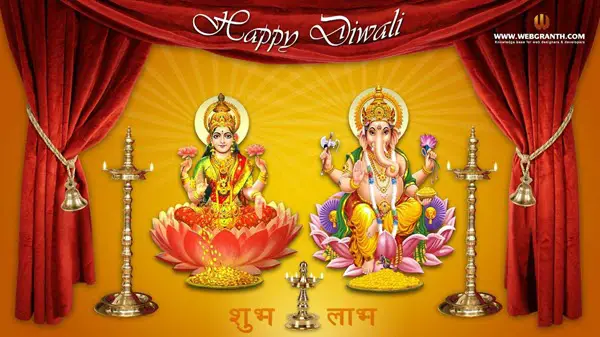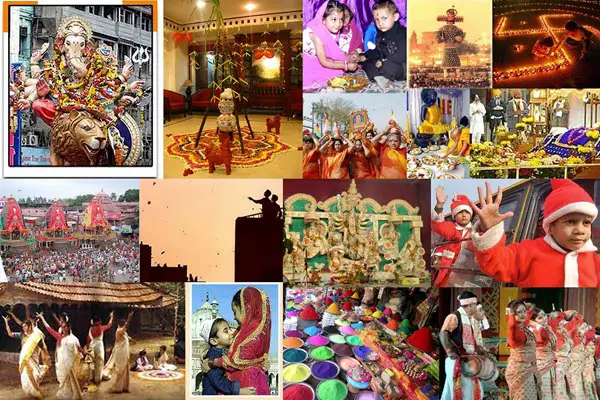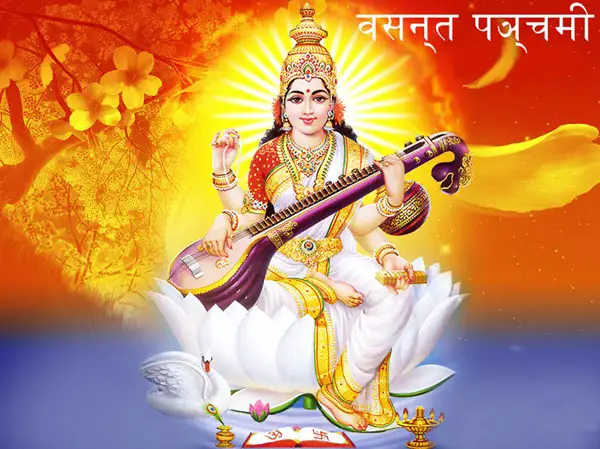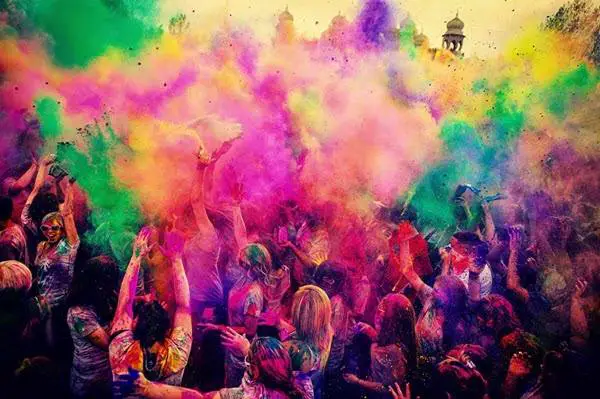Jagannath Rath Yatra, or Chariot Festival, is a hugely popular festival of the Hindus. It is celebrated yearly on the second day of the Shukla Paksha in the Hindu month of Asadh, the third month of India’s Hindu lunar calendar. It usually falls in June or July.
The epicenter of this festival is the world-famous Jagannath Puri Temple in Orissa. The Jagannath Puri Temple is considered one of the four major Hindu shrines called the “Char Dham.”
The other three are Badrinath in the Himalayas, Dwarka in the West, and Rameshwaram in the South. Jagannath Puri is the world’s only temple where you will find statues of three siblings: Lord Krishna, Balaram, and Subhadra.
The Jagannath Rath Yatra is a top-rated tourist attraction. Millions of devotees from all across the globe participate in this Chariot Festival.
The Jagannath Rath Yatra is an annual event dedicated to Lord Jagannath (Lord Krishna), his elder brother Balabhadra (Lord Balaram), and his sister Goddess Subhadra.
The Jagannath Rath Yatra is also called Cart Festival, Chariot Festival, Rath Yatra, Gundicha Yatra, Ghosha Yatra, Dasavatara and Navadina Yatra.
The Jagannath Rath Yatra is organized in Puri, Orissa.
Jagannath Rath Yatra is regarded as one of the Hindus’ oldest and grandest procession festivals. It also mentions Hindu religious texts such as Brahma Purana, Padma Purana, and the Skanda Purana.
According to Hindu religious beliefs, it is said that Lord Jagannath wishes to visit his birthplace Mathura for a few days each year. Thus, devotees carry the Rath Yatra from Jagannath Temple to Gundicha Temple to fulfill this desire.
On the Rath Yatra day, all three deities, namely Lord Jagannath, Balabhadra, and Subhadra, are taken out of the Jagannath Temple and placed in their respective fields chariots, which are kept near the Singhadwar.
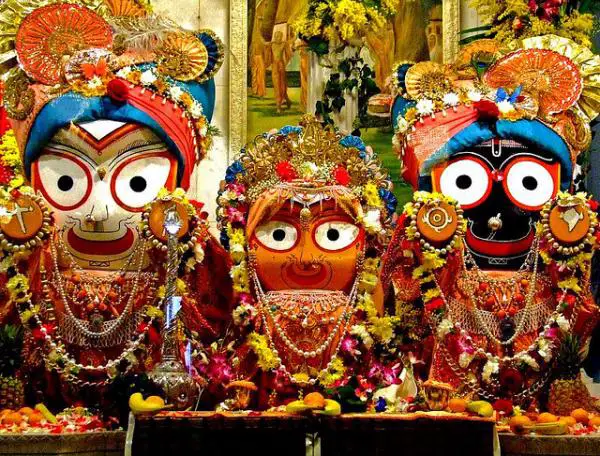
The whole procession is performed traditionally, wherein first, Sudarshan, followed by Balabhadra, Subhadra, and Jagannath, is carried to the chariots.
The idols of Lord Jagannath and Balabhadra are made to swing in a forward and backward direction in a manner called ‘Pahandi.’
Table of Contents
Procession during Jagannath Rath Yatra
According to Hindu religious beliefs, The Jagannath Puri Temple is known as the ‘Yamanaka Tirtha’ where the god of death’s power, ‘Yama,’ has been nullified due to the divine presence of the Lord Jagannath and his siblings – Lord Balabhadra and deity Subhadra.
For the Ratha Yatra, as many as three new splendid chariots are created for the Gods Lord Jagannath and his siblings yearly.
The carpenters who construct the chariots have rights for the job by heredity. They follow century-old styles mentioned in the Hindus’ religious texts for building and decorating chariots.
Each year the wooden idols of Lord Jagannath, Balabhadra, and Subhadra are carried in three decorated chariots from the Jagannath Temple to the Gundicha Temple.
Chants and conches accompany the whole procession. The atmosphere is full of joy and immense devotion. Millions of devotees can be seen participating in this procession festival.
Before the Ratha Yatra commencement, there is ceremonial bathing of the idols with 109 buckets of water, known as Snana Poornima. After the ceremonial bathing, the idols are isolated until the day of the procession.
The event is known as ‘Ansara.’ The holy ritual of Chhera Pahara is performed on the day of the procession by the royal successor of Orissa. Hordes of locals and devotees can be seen around the temple premises during the performance of Chhera Pahara.
During Chhera Pahara, the King brings the deities’ idols from the temple and places them on the chariot. Before this, the King sweeps the chariot floor with a broom with a golden handle.
The King also decorates the chariots with flowers with his hands. The ground is also cleaned, and sandalwood is sprinkled on it. This ceremony signifies that everyone is equal in the eyes of the Lord.
Although the Jagannath Temple can be accessed only by the Hindus, on the day of the Ratha Yatra, it can be visited by people of all faiths.
As per the tradition, all three deities remain at the Gundicha Temple for nine days, after which they return to the Jagannath Temple.
The return journey is known as the ‘Bahuda Yatra.’ When the deities return to the Jagannath Temple, they are adorned with new clothes. The event is called “Suna Besha.” They are placed in the sanctum sanctorum, marking the end of the Jagannath Ratha Yatra.
The Chariots in Jagannath Rath Yatra
One of Jagannath Ratha Yatra’s significant aspects is the chariots of the deities of Lord Jagannath, Balabhadra, and Subhadra, which carry them from the Jagannath Temple to the Gundicha Temple during the Ratha Yatra.
The chariots are the prime attraction of the Jagannath Ratha Yatra.
There are three chariots: Lord Jagannath, Lord Balabhadra, and Goddess Subhadra. The preparation of the chariots begins on the day of Akshaya Tritiya. All three chariots are decorated beautifully with the help of designs, prints, and motifs.
They are pulled by the devotees using long ropes, which are about 50 m in length. The pulling of the chariots is considered a sacred activity and is religiously done by the devotees. It is believed that pulling off the chariots’ ropes adds to your good karma and washes the bad sins that have been committed.

The chariots are sprawling structures and span about 45 feet in height. The chariot of Lord Jagannath is known as the Nandighosha. It has 16 wheels and is about 45.6 feet in height. The chariot’s roof is covered with red and yellow fabrics.
Bhagwan Balabhadra’s chariot is known as Taladhwaja and is 45 feet tall. It has 14 wheels. The colors of the fabrics used to cover the roof of the chariot are red and green. Goddess Subhadra chariot has 12 wheels and is 44.6 feet in height. It is known as ‘Devadalana.’ Its fabrics are red and black.
Sudarshan is placed beside Subhadra in her chariot.
Madanmohan, which is a representative deity of Jagannath, is placed in the chariot of Lord Jagannath.
Two small idols of Rama and Krishna are placed in the chariot of Balabhadra. These small idols of Rama and Krishna are made of metal.
So, there are seven deities, namely Jagannath, Subhadra, Balabhadra, Sudarshan, Madanmohan, Rama, and Krishna, seated on three chariots. These seven deities are moved to Gundicha Temple from Jagannath Temple. The distance between the Jagannath Temple and the Gundicha Temple is about 3 km.
As the procession starts, the chariot of Lord Balabhadra is moved first, followed by those of Subhadra and Jagannath. Chants and drum beating accompany the whole procession as the chariots are dragged enthusiastically by the devotees to the Gundicha Ghar. The deities stay at the Gundicha Temple for the next nine days, where devotees can seek their blessings.
During the Yatra’s return, the procession halts at the Mausi Maa Temple. Here the deities are served with Poda Pitha, a sweet pancake.
An important ritual is performed on the fifth day, known as ‘Hera Panchami’, when Goddess Lakshmi moves to Gundicha Temple to see Lord Jagannath.
On the evening of the 10th day, the ‘Hari Sayan Ekadashi’ ritual is performed. The deities are decorated with gold ornaments and dressed gorgeously in their respective chariots parked in the Singhadwar area. On the 12th day of the bright fortnight, a ceremony known as the ‘Adharapana Bhog’ is carried out wherein the deities offer a sweet drink.
Finally, on the following day’s evening, the deities are moved to the Jagannath Temple in a ritualistic procession in which thousands of devotees participate.
Puri Ratha Yatra 2024
The Jagannath Rath Yatra Date is 7th July 2024, Sunday.
We hope you liked this article on Jagannath Puri Rath Yatra. Don’t forget to share this post with your friends and family.

